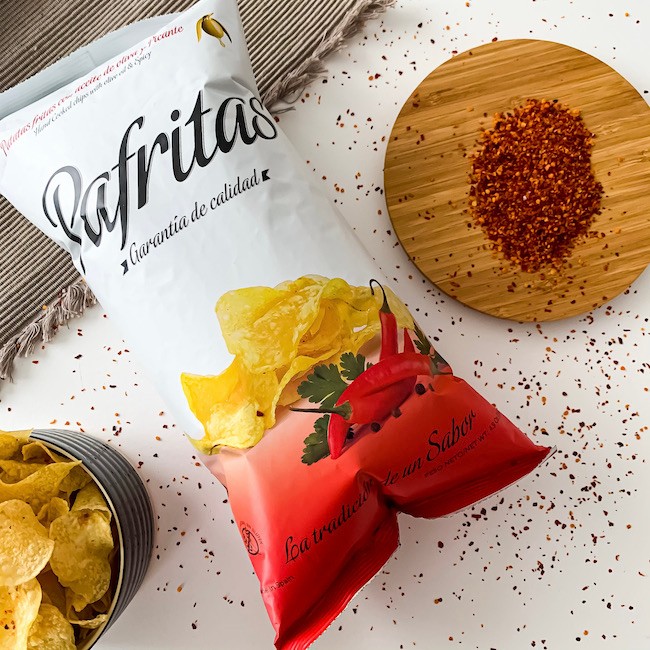Could a simple snack truly encapsulate the essence of a nation's culinary soul? The answer, surprisingly, might be found in the humble potato chip, specifically, the Spanish potato chip. This seemingly trivial treat reveals a fascinating tapestry of language, regional variations, and the pursuit of the perfect crisp.
The world of potato chips, or "chips" as they are often referred to, is a linguistic minefield, particularly when crossing borders. What an American calls "chips," a Brit might call "crisps." Even within the same language, regional dialects play a significant role, with the Spanish language being no exception. Navigating these nuances is key to avoiding confusion and, more importantly, finding the crispiest, most flavorful chip experience.
Let's delve into the Spanish lexicon of chips. The most direct translation, and the most common, is "papas fritas" or "patatas fritas," both meaning "fried potatoes." However, this term often encompasses both French fries and potato chips, leading to potential ambiguity. To specify potato chips, you might encounter "papas chips." In some regions, particularly in Mexico, "totopos" might be used, though they often refer to tortilla chips. "Papitas" is another informal term, translating to "little potatoes," and is a safe bet for communicating your chip cravings.
The very concept of "chips" as a distinct food item is, in a sense, a cultural construct. The English-speaking world has normalized a specific form of thinly sliced, deep-fried potatoes. These come in a multitude of flavors, from the classic salt and vinegar and cheese and onion to more adventurous options. But in Spain, and much of the Spanish-speaking world, the focus often remains on the quality of the potato and the simplicity of the preparation. As someone pointed out, "We don't have a word for chips the same way you use it in English, because the literal translation for chips in Spanish is papas/patatas fritas and that's referring only to potato chips."
The regional variations add another layer of complexity. In Mexico, "Sabritas" is a brand name that has become synonymous with potato chips, used almost as a generic term, much like "Kleenex" for facial tissues. In Colombia, the distinction is clear: "papas a la francesa" for French fries, and "papas chips" for potato chips. As one source put it "This is just my experience, this is one of the words that varies wildly from place to place." This highlights the importance of context when ordering or discussing chips in Spanish-speaking countries. In New Zealand, both are usually just "chips" and the meaning is extracted from the general scenario. It makes a lot of sense. If you are talking about McDonalds, it might be more than clear that it is about fries.
Let's not forget the nuances of flavors. In the United States and Britain, a wide range of flavors is the norm, with the salt and vinegar and cheese and onion often being considered staples. But in Spain, the focus often rests on high-quality ingredients and simple preparation. The De la Vera hot smoked paprika chips, for example, are an excellent example of quality and simplicity. The authentic Spanish flavor in every crisp bite is a testament to the country's food soul.
The origin of the modern potato chip remains a matter of debate, with various stories circulating. What is not debatable, however, is the chip's global appeal. Its crunchy texture, combined with its potential for infinite flavor variations, has made it a beloved snack across cultures. The Spanish version, with its focus on quality ingredients and traditional methods, offers a unique and satisfying experience.
Consider the humble potato, sourced from the Xinzo de Limia region in Galicia, Spain. These potatoes are carefully selected for their perfect balance of sugars and starch. They are then cooked in olive oil, and finished with a light dusting of salt. This simple process results in a chip that's crispy, flavorful, and a true testament to the ingredients. The fact that such a product is packed in a reusable tin highlights the sustainability of the manufacturing.
The creation of the perfect potato chip is not just a matter of taste; it's also a matter of shelf life. Potato chips, particularly those made with natural ingredients, have a relatively short shelf life. Temperature control is critical, as the oil can quickly go rancid. Brands like "TDP Specialties" understand this, focusing on quality control and offering a wide variety of chip selections to the consumer.
The brand "Torres," established in 1969, is a prime example of Spanish chip excellence. Their chips, made near Barcelona, are imported to the United States and are celebrated for their authentic Spanish flavor and quality. Chips and tapas mean moments of fair, party and joy.
| Feature | Details |
|---|---|
| Origin | Spain |
| Key Ingredients | Potatoes, Extra Virgin Olive Oil, Sea Salt |
| Production Method | Potatoes are thinly sliced, fried in olive oil, and lightly salted |
| Notable Brands | Torres, Bonilla a la Vista |
| Regional Variations | "Papas fritas/patatas fritas" (general term), "Papas chips" (potato chips specifically), "Papitas" (informal term), "Totopos" (in some regions) |
| Flavor Profiles | Often focus on the natural flavor of the potato, with simple seasoning; flavors like De la Vera hot smoked paprika are common. |
| Shelf Life | Generally short; temperature control is crucial to prevent oil rancidity. |
| Cultural Significance | Chips and tapas are associated with moments of joy and festivity. |
| Key Characteristics | Crispy texture, authentic Spanish flavor, high-quality ingredients. |
| Reference | Your Spanish Shop |
From the specific translations of "chips" in Spanish to the regional variations and the emphasis on quality ingredients, the world of Spanish potato chips provides a unique lens through which to appreciate the country's culinary culture. The next time you reach for a bag of chips, consider the journey of the humble potato, from the fields of Galicia to the satisfying crunch in your mouth.


